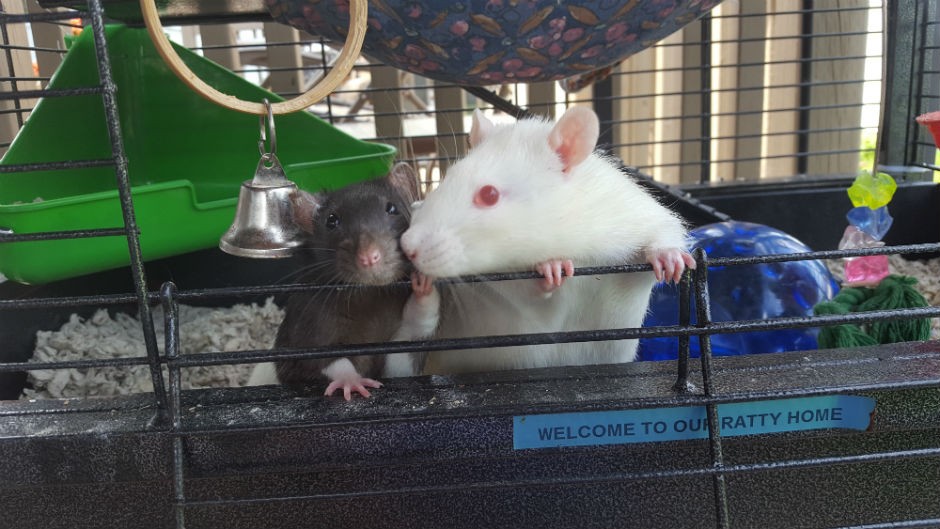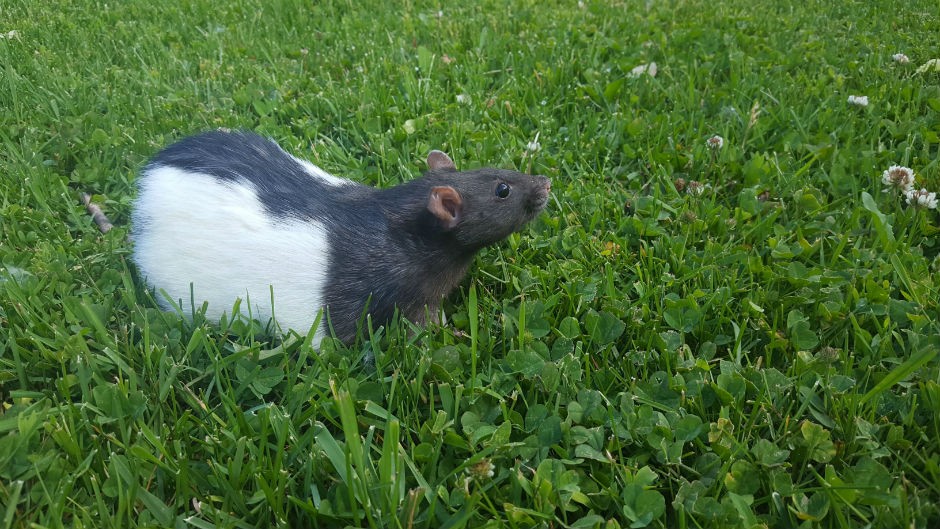Milan Valyear has a Master’s degree in psychology from Wilfrid Laurier University and is currently a doctoral candidate at the Center for Studies in Behavioral Neurobiology at Concordia. He studies addiction in the lab of Dr. Nadia Chaudhri and is particularly interested in the neural systems that control how cues in the environment trigger relapse. Using cutting-edge neuroscience tools, he is able to silence specific neural pathways when rats are presented with alcohol cues and observe how they respond.
Blog post
Do rats imagine?
 These two rats were adopted as pets after an experiment. The rat on the left is named Lori and the rat on the right is named Timmy.
These two rats were adopted as pets after an experiment. The rat on the left is named Lori and the rat on the right is named Timmy.
One of the reasons that rats are so prominently used in psychology research is that they are able to perform complex and interesting behaviours that are relevant to humans. It is tempting to assert that rats and humans accomplish tasks through similar psychological means. Here, I attempt to answer the question, do rats imagine?
Humans often use their imagination to solve tasks. We envision the outcomes of different courses of action to choose the appropriate course. Imagining future outcomes can be as elaborate as choosing a university to attend or as mundane as turning left or right at the end of a corridor.
In deciding to attend a university one might imagine themselves in the library, listening to lectures, or studying at near-by coffee shops. The decision to turn left or right at the end of a corridor, while less involved, still requires a person to imagine themselves traversing two distinct paths: a hallway of windows versus a hallway of lockers, for example.
I will limit the discussion here to the visual modality of imagination, particularly as it pertains to navigation, and assume that at least a subset of similar psychological operations is performed during elaborate and mundane imaginations.
Rats will readily learn to navigate a maze to find a tasty food reward in the goal box at the end of the maze. Interestingly, rats will learn to navigate the maze even if there is no food reward in the goal box. If a rat is allowed to explore an empty maze for sufficient time, they then can solve the maze immediately once a food reward is introduced into the goal box1.
Rats are able to use information they gained through passive exploration to help them efficiently navigate the maze. It is as if rats form a map of the maze in their mind when the passively explore, and then imagine that map to aid their navigation when there is an incentive to complete the maze.
This intriguing finding could be evidence of imagination but there are alternate explanations: rats may simply become familiar and less anxious in the maze which aids their learning about the maze when a food reward becomes available.
What are the brain processes involved in imagining? When humans imagine or perceive an image, similar patterns of activity are produced in the visual cortex2 which is a brain area that processes visual information3. Is this also true for rats? This is a difficult question to answer because rats cannot be verbally prompted to imagine.
Interestingly though, blind rats can be trained to navigate a maze. Because these rats are blind they must use non-visual information to navigate the maze. It might be predicted then that the visual cortex of a blind rat is not involved in maze navigation.
Surprisingly, the visual cortex is necessary for maze navigation because damage to the visual cortex impairs performance on the maze in blind and sighted rats4. This peculiar finding might suggest that, despite learning the maze using non-visual information, rats used visual imagery to help navigate the maze.

There are of course alternate explanations for this finding. The visual cortex may serve purposes other than imagination which aid in spatial navigation, or brain damage may perturb general brain function which impedes navigation in rats.
When rats are at a choice-point in a maze where they must decide which way to turn, they look back and forth down both paths repeatedly before advancing in one direction5,6. This interesting behaviour should be familiar to anyone who has searched for their car in a parking lot glancing down aisles of cars before deciding on a direction to pursue.
When a rat must decide on a path, and they exhibit repeated head sways, it is as if they are imagining the consequences of traversing either path.
The hippocampus is a brain region that is important for memory and navigation. Within the hippocampus are place cells which are neurons that become active only in particular spatial locations7,8. For example, a person might have place cells that become active only when they are in their kitchen and different cells that become active when they are sitting on their couch.
It is thought that these place cells allow animals to create a map of the environment. When rats navigate a maze, neuroscientists can record electrical activity from multiple place cells and observe in which positions different place cells become active.
Interestingly, when a rat is at a choice-point in a maze, swaying their head left and right deciding on a path, place cells that usually become active only when the rat is located in a position to the left or right become active during head-sways in the corresponding direction.9 The place cells in front of the rat begin to fire as they would if the rat was traversing the position left or right.
While we cannot infer psychological processes from brain activity alone, it is intriguing that the same cells that are active when a rat is located in a place, also become active when a rat is decides to enter that place.
Defining psychological processes so that they can be studied in rats is a major challenge for neuroscientists. It is difficult to define imagination in a way that can be measured in rats. I have argued that visual imaginations that serve to aid maze navigation in rats are akin to imaginations in humans. We do not know if rats imagine in the same way that humans do.
We do know, however, that rats can use spatially relevant information that they have gained through passive exploration to solve a maze. We know that navigating a maze blind requires areas in the brain that are involved in visual perception. The most convincing evidence for imagination in rats is that cells in the brain that are active when a rat is positioned in a place are also active when the rat is deciding whether to advance toward that place.
1. Blodgett, H. C. The effect of the introduction of reward upon the maze performance of rats. Univ. Calif. Publ. Psychol. 4, 113–134 (1929).
2. Farah, M. J. The neural basis of mental imagery. Trends Neurosci. 12, 395–399 (1989).
3. Principles of Neural Science. (McGraw-Hill, 2000).
4. Lashley, K. S. Studies of cerebral function in learning XII. Loss of the maze habit after occipital lesions in blind rats. J. Comp. Neurol. 79, 431–462 (1943).
5. Tolman, E. C. Prediction of vicarious trial and error by means of the schematic sowbug. Psychol. Rev. 46, 318–336 (1939).
6. Redish, A. D. Vicarious trial and error. Nat. Rev. Neurosci. 17, 147–159 (2016).
7. O’Keefe, J. & Nadel, L. The Hippocampus as a Cognitive Map. (Oxford University Press, 1978).
8. O’Keefe, J. A review of the hippocampal place cells. Prog. Neurobiol. 13, 419–439 (1979).
9. Johnson, A. & Redish, A. D. Neural ensembles in CA3 transiently encode paths forward of the animal at a decision point. J. Neurosci. 27, 12176–12189 (2007).
About the author


